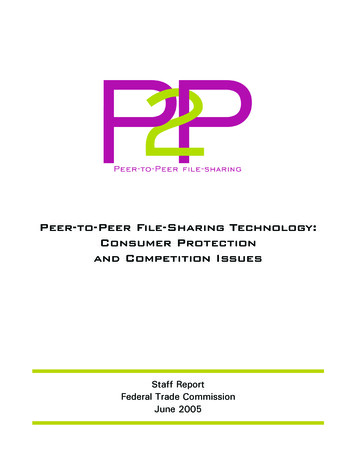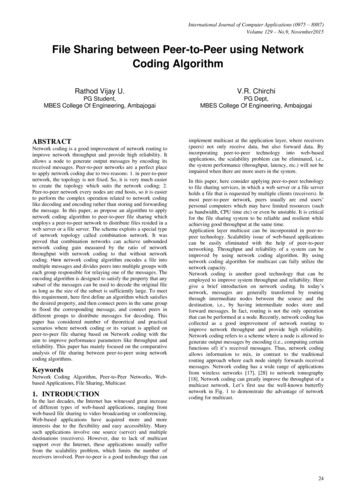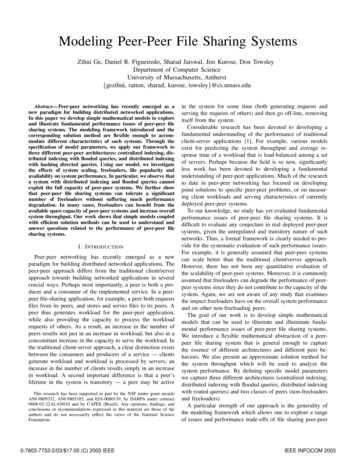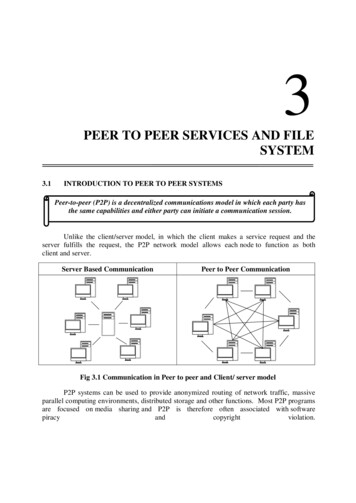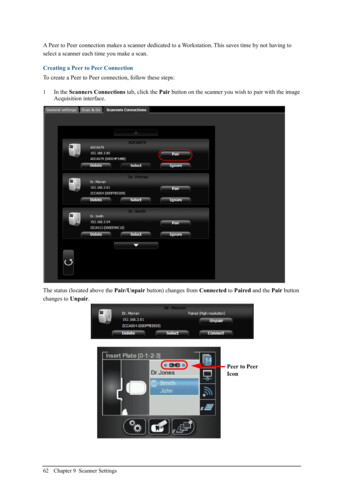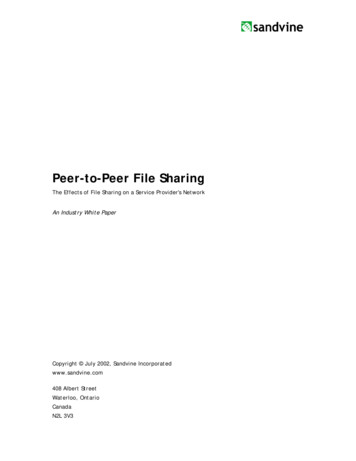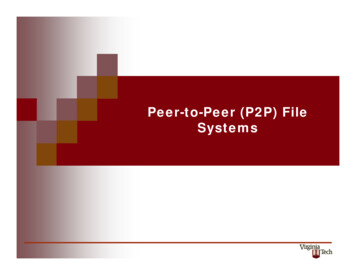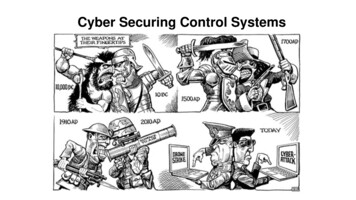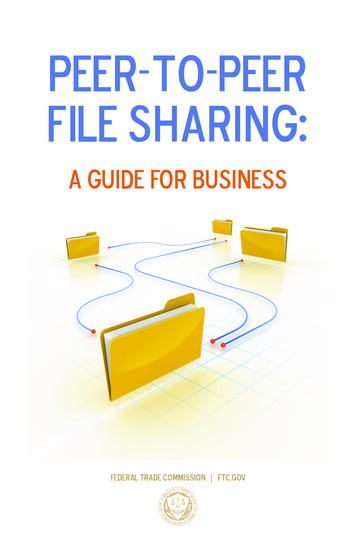
Transcription
Peer-to-PeerFile Sharing:A Guide for BusinessFederal Trade Commission ftc.gov
Most businesses collect and store sensitive information abouttheir employees and customers, like Social Security numbers,credit card and account information, and medical and otherpersonal data. Many of them have a legal obligation to protect this information. If it gets into the wrong hands, it couldlead to fraud and identity theft. That’s why any company thatcollects and stores sensitive information must consider thesecurity implications of using Peer-to-Peer (P2P) file sharingsoftware and minimize the risks associated with it.What is Peer-to-Peerfile sharing software?Peer-to-Peer (P2P) technology is a way to share music, videoand documents, play games, and facilitate online telephoneconversations. The technology enables computers using thesame or compatible P2P programs to form a network andshare digital files directly with other computers on the network. Because virtually anyone can join a P2P network just byinstalling particular software, millions of computers could beconnected at one time. BearShare, LimeWire, KaZaa, eMule,Vuze, uTorrent and BitTorrent are examples of P2P file sharing programs.When P2P file sharing software is not configured properly,files not intended for sharing may be accessible to anyone onthe P2P network. The Federal Trade Commission (FTC), thenation’s consumer protection agency, has written this guide tohighlight the security problems that can result when organizations allow their employees – and others with access to theirnetworks – to use P2P file sharing software. The guide alsonotes measures network administrators or security professionals can use to address these problems.1
Security risksP2P file sharing programs allow computers to download filesand make them available to other users on the network. P2Pusers can designate the drives and folders from which files canbe shared. In turn, other users can download and view any filesstored in these designated areas.People who use P2P file sharing software can inadvertentlyshare files. They might accidentally choose to share drives orfolders that contain sensitive information, or they could save aprivate file to a shared drive or folder by mistake, making thatprivate file available to others. In addition, viruses and othermalware can change the drives or folders designated for sharing,putting private files at risk. As a result, instead of just sharingmusic, a user’s personal tax returns, private medical records orwork documents could end up in general circulation on P2Pnetworks. Once a user on a P2P network downloads someoneelse’s files, the files can’t be retrieved or deleted. What’s more,files can be shared among computers long after they have beendeleted from the original source computer. And if there aresecurity flaws or vulnerabilities in the P2P file sharing softwareor on an organization’s network, the P2P program could openthe door to attacks on other computers on the network.The decision to ban or allow P2P file sharing programs onyour organization’s network involves a number of factors. Forexample, what are the types and locations of sensitive information on your network? Which computers have access tofiles with sensitive information? What security measures arealready in place to protect those files?If your network has sensitive information that isn’t necessaryto conduct business, your best bet is to delete it – securely andpermanently. To help you determine the kinds of files that2might be deleted, read Protecting Personal Information: A Guidefor Business (www.ftc.gov/infosecurity).But if your network has sensitive information that is necessary to conduct business, weigh the benefits of using P2P filesharing programs against the security risks associated withthe programs. Is there a business need to share files outsideyour organization? If so, are there more secure ways for youremployees to share files?Whether you decide to ban P2P file sharing programs onyour network or allow them, it’s important to create a policyand take the appropriate steps to implement and enforce it.That will reduce the risk that any sensitive information will beshared unintentionally. Among the questions to consider: If you decide to ban P2P file sharing programs, how willyou prevent these programs from being installed andused? If you decide to allow P2P file sharing programs, howwill you protect the sensitive information stored on yourorganization’s network? If you allow employees, contractors, or vendors to usenon-network computers for remote access, what additional steps will you take to protect sensitive files frombeing shared through P2P file sharing programs installedon those computers? How will you train your employees about the risks ofusing P2P file sharing programs? Will you impose sanctions if your policies are not followed? How will you determine if your policies are effective?3
Protecting SensitiveInformation on Your NetworkThere’s no shortcut when it comes to dealing with P2Pfile sharing security concerns. Regardless of whetheryou choose to allow P2P file sharing programs, takethese steps to ensure that the sensitive information onyour network is secure: Delete sensitive information you don’t need, andrestrict where files with sensitive informationcan be saved. Minimize or eliminate the use of P2P file sharing programs on computers used to store oraccess sensitive information. Use appropriate file-naming conventions. Monitor your network to detect unapprovedP2P file sharing programs. Block traffic associated with unapproved P2Pfile sharing programs at the network perimeteror network firewalls. 4Train employees and others who access yournetwork about the security risks inherent inusing P2P file sharing programs.If you decide to ban the use of P2P filesharing programs.A decision to ban P2P file sharing programs altogether requirespolicies and procedures to prevent these programs from beinginstalled on computers on your network, and to detect any P2Pprograms that have been installed – and block traffic associatedwith them.To prevent P2P file sharing programs from being installed: Use administrative security controls to block accessfrom your network to sites used to download P2P filesharing programs. You can filter sites based on URL,IP address, filename and content, or you can use commercial products designed to do the job. The controlsalso should block access to sites that offer free softwaredownloads; these sites often are sources of P2P file sharing programs. Use administrative security controls to prevent employees from installing unapproved programs on your organization’s computers.To detect P2P file sharing programs already installed – andblock traffic associated with them: Use scanning tools on individual computers and networks often to find P2P file sharing programs andremove them. Commercially available scanning tools canidentify many P2P programs.5
6Install tools that allow network administrators torestrict, monitor and otherwise manage access to P2Pfile sharing networks from your corporate network,including intrusion detection systems (IDS), intrusionprevention systems (IPS) or firewalls that detect P2Ptraffic and restrict appropriate inbound and outboundconnections to the Internet. Configuring these toolsmay require research because different P2P file sharingprograms use different protocols. Commercial hardwareand software providers may be helpful. Install tools that create records of file transfers based onthe configuration of IDS, IPS and firewalls to detect andcontrol P2P traffic. Use network monitoring tools and techniques like flowreconstruction to identify whether your network hasP2P traffic and to determine the nature – and maybe thenames and contents – of files that have been sent to andfrom your network using P2P file sharing programs. Review records and activity logs on your network toidentify traffic volume spikes that may indicate big filesor a large number of small files are being shared. Install data loss prevention tools that inspect filesflowing from your network to determine whether theycontain certain types of sensitive information, like SocialSecurity numbers. Regularly review the records thesetools create to determine whether sensitive informationis being exported.To protect sensitive information: Restrict the locations to which work files containing sensitive information can be saved or copied. For example,you can create designated, well-defended network serversto house these files or use a file management program.These kinds of tools and techniques isolate sensitiveinformation and may limit the extent to which P2P filesharing programs need to be banned. If possible, use application-level encryption to protect theinformation in your files. This type of encryption canhelp protect files that are shared inadvertently on P2Pnetworks. If you use encryption, keep the passwords andencryption keys safe: make sure they are not available indrives or folders designated for sharing. Use file-naming conventions that are less likely todisclose the types of information a file contains. Forexample, it’s easy to spot terms like “ssn,” “tax,” or “medical” within a filename. If you find an unauthorized P2P program on your network, monitor it for sensitive information, either directlyor by using a third-party service provider. Becausesearch terms can be viewed by others on P2P networks,be careful about the terms you use. Some search terms(such as those that include “ssn”) may increase the riskto sensitive information, while others (such as companyor product name) likely will not. To help manage theserisks, consult a security professional.7
If you decide to allow P2P file sharingprograms.To protect sensitive information: Restrict the locations to which work files containing sensitive information can be saved or copied. For example,you can create designated, well-defended network serversto house these files or use a file management program.These kinds of tools and techniques isolate sensitiveinformation and may limit the extent to which P2P filesharing programs need to be banned. If possible, use application-level encryption to protect theinformation in your files. This type of encryption canhelp protect files that are shared inadvertently on P2Pnetworks. If you use encryption, keep the passwords andencryption keys safe: make sure they are not available indrives or folders designated for sharing. Use file-naming conventions that are less likely todisclose the types of information a file contains. Forexample, it’s easy to spot terms like “ssn,” “tax,” or “medical” within a filename. Monitor P2P networks for sensitive information, eitherdirectly or by using a third-party service provider.Because search terms can be viewed by others on P2Pnetworks, be careful about the terms you use. Somesearch terms (such as those that include “ssn”) mayincrease the risk to sensitive information, while others(such as company or product name) likely will not. Tohelp manage these risks, consult a security professional.If you decide to allow P2P file sharing programs on yourorganization’s computers, it’s smart to control their use to try toprevent unauthorized file sharing.First, review various P2P file sharing programs, and select onethat is appropriate for your organization. Next, permit onlythe approved program and configuration.To control the installation of approved P2P file sharingprograms: Provide the approved program directly to authorizedusers from an internal server rather than from a publicdownload site. That can reduce the chance that the program will contain viruses or other malware.To control the use of approved P2P file sharing programs:8 Update the approved P2P program often from anauthorized and verified source to incorporate the latestsecurity patches. Block outbound traffic through the approved P2P filesharing program to prevent sharing the types of files thatmost often contain sensitive information, including filesthat have the suffixes .doc, .docx, .xls, .xlsx, .mda, .mdb,.txt and .pdf. If these are the types of files your businessneeds to share, consider using a program other than aP2P file sharing program. Use the tools and techniques already cited to detectunapproved P2P file sharing programs (or unauthorizedversions of approved P2P programs) on your networkand to block traffic associated with them.9
If you allow remote access to yournetwork.Training employees and others aboutP2P file sharing programsWhether you ban P2P file sharing programs or allow them,additional measures may be appropriate when employees, contractors, vendors, service providers or others can access sensitive information on your network remotely.These days, keeping sensitive information secure really is everyemployee’s responsibility. Regardless of whether you ban theuse of P2P file sharing programs or allow it, everyone whohas access to sensitive information on your network should betrained about the security risks associated with these programs.If you allow the use of P2P file sharing programs, effectivetraining should demonstrate how to restrict drives or folders tolimit what other P2P users can view. It should emphasize theimportance of keeping files with sensitive information out ofP2P shared drives and folders and minimizing the amount ofsensitive information on computers using P2P file sharing programs. For more information, read P2P File-Sharing: Evaluatethe Risks htm). Consider what sanctions might be appropriate if your organization’s policies about using P2P file sharingprograms are not followed or if files containing sensitive information are shared on P2P networks contrary to those policies.Training your employees about securing sensitive informationsends the message that your organization believes in keepingpersonal information private.To protect sensitive information while allowing remoteaccess: Provide dedicated company computers to employees whoaccess your network remotely, rather than allowing themto use their own personal computers. The computersyou provide should have the same security measures andprotections you use at work to prevent, detect and blockunauthorized file sharing to P2P networks. Require remote access to proceed only through secureconnections to your organization’s network, like VirtualPrivate Network (VPN) software or Secure SocketsLayer (SSL). This is appropriate for employees who telework – or for customers or suppliers who need regularaccess to your system. Restrict the locations to which work files containingsensitive information can be saved or copied, and permit remote users to access, use or modify the files – butnot to download them. If you allow people to use theirpersonal computers to download files from your organization’s network, consider requiring them to securelydelete your files from their computers when they are notusing the files. 10Exercise due diligence to ensure that customers, suppliers, contractors, vendors, service providers and otherthird parties that access your network use appropriatesecurity policies and procedures to address risks associated with P2P file sharing programs.Evaluating your policiesEvaluate your security measures regularly to be sure they aredoing the job. Circumstances change, equipment and softwarebecome outdated, and people make mistakes. As a result, effective security is dynamic, and requires monitoring and updating.11
Additional Resources www.ftc.gov/infosecurity www.OnGuardOnline.gov www.sans.org/top20 www.us-cert.govThe FTC works for the consumer to prevent fraudulent,deceptive and unfair business practices in the marketplaceand to provide information to help consumers spot, stop andavoid them. To file a complaint or to get free information onconsumer issues, visit ftc.gov or call toll-free 1–877–FTCHELP (1–877–382–4357); TTY: 1–866–653–4261. TheFTC enters Internet, telemarketing, identity theft, and otherfraud-related complaints into Consumer Sentinel, a secureonline database available to hundreds of civil and criminal lawenforcement agencies in the U.S. and abroad.1213
Federal Trade Commission ftc.gov
P2P file sharing programs allow computers to download files and make them available to other users on the network. P2P users can designate the drives and folders from which files can be shared. In turn, other users can download and view any files stored in these designated areas. People who use P2P file sharing software can inadvertently share .
